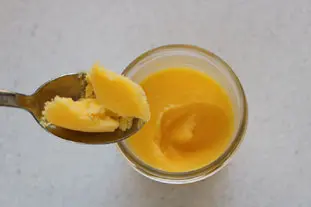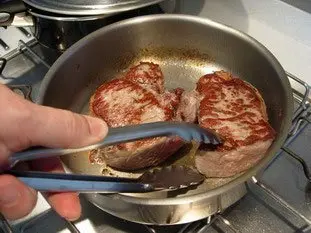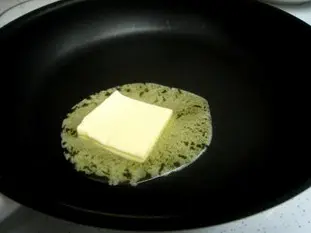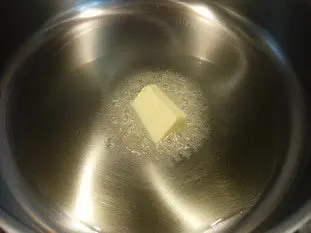This site uses only a few technical cookies necessary for its operation. By continuing to browse, you accept their use.
To find out more...
To find out more...
Fats for cooking

If you need to fry or sear anything a frying pan or saucepan, the temperature is likely to be high.
In particular, I have cooking red meat in mind. In this case, what should fat should we use? And at what temperature?
In particular, I have cooking red meat in mind. In this case, what should fat should we use? And at what temperature?
21 K 5/5 (13 reviews)
Last modified on: January 23th 2018
Fats for cooking
For our red meat, let's imagine we want to fry a tournedos (let's go straight for something top-of-the-range). The same goes for this as for all other fried or seared red meat, and there's no secret: really, really hot; the meat should be seared or flash fried.
So much for the temperature, but what about the fat? For simplicity's sake, let's narrow this down to two possibilities: butter or oil.
Oil: No problem with this; the oil will take being heated to a high temperature. There's a trick to knowing when it is hot enough => it will begin to give off a light smoke. Look out for this and as soon as it happens, put your meat in the pan. Do be careful, though; you need to react quickly and not let it burn and smoke too much.
Butter: This presents more of a problem. Butter will not take high temperatures. To start with, it melts and foams, so we might go ahead and add the meat at that point. But as the temperature continues to rise, the butter will end up burning and give a very unpleasant, bitter flavour.
So, as you can see, if you want to cook at a very high temperature, it is better to use oil, as butter is unsuitable.
That's all very well, but oil doesn't taste the same as butter and doesn't give the same flavour to the meat; generally, butter makes it taste better (yes, taste also matters). So, is there really no way to fry meat in butter?
As it happens, there is – but not with normal butter. We need to use clarified butter, which is butter that has been separated off from the white milk solids, which you can see as the little bits in the photo above. These would end up burning and turning brown during frying. It is fairly simple to make and keeps very well.
There is a third way, using a mixture of the two: a little oil in the bottom and then butter added. This allows the temperature to be raised higher than for ordinary butter alone, but clarified butter is still the better option by far.
To sum up: When cooking red meat, always fry it at high temperature, and for the fat, use oil or clarified butter.
So much for the temperature, but what about the fat? For simplicity's sake, let's narrow this down to two possibilities: butter or oil.
Oil: No problem with this; the oil will take being heated to a high temperature. There's a trick to knowing when it is hot enough => it will begin to give off a light smoke. Look out for this and as soon as it happens, put your meat in the pan. Do be careful, though; you need to react quickly and not let it burn and smoke too much.

Butter: This presents more of a problem. Butter will not take high temperatures. To start with, it melts and foams, so we might go ahead and add the meat at that point. But as the temperature continues to rise, the butter will end up burning and give a very unpleasant, bitter flavour.

So, as you can see, if you want to cook at a very high temperature, it is better to use oil, as butter is unsuitable.
That's all very well, but oil doesn't taste the same as butter and doesn't give the same flavour to the meat; generally, butter makes it taste better (yes, taste also matters). So, is there really no way to fry meat in butter?

As it happens, there is – but not with normal butter. We need to use clarified butter, which is butter that has been separated off from the white milk solids, which you can see as the little bits in the photo above. These would end up burning and turning brown during frying. It is fairly simple to make and keeps very well.
There is a third way, using a mixture of the two: a little oil in the bottom and then butter added. This allows the temperature to be raised higher than for ordinary butter alone, but clarified butter is still the better option by far.

To sum up: When cooking red meat, always fry it at high temperature, and for the fat, use oil or clarified butter.
Lasts posts
Butter vs. grease
We often read in a recipe where a pastry is put into a mould that, just before pouring, the mould should be buttered or greased. But what's the difference between these 2 terms?December 1st 20254925
Getting out of the fridge early
Very often when you're cooking, you need to take food or preparations out of the fridge, to use them in the recipe in progress. There's nothing tricky about this: you just take them out of the fridge and use them, usually immediately, in the recipe. But is this really a good method?November 24th 20258995
Who's making the croissants?
When you look at a bakery from the outside, you naturally think that in the bakery, the bakers make the bread, and in the laboratory, the pastry chefs make the cakes. It's very often like that, with each of these professions having quite different ways of working, but sometimes there's also one...November 23th 2025798
Oven height
When we put a dish or cake in the oven, we naturally tend to put it on the middle shelf, and that's what we usually do. But in some cases, this position and height can be a little tricky, so let's find out why.October 8th 20252,3785
The importance of sieving
In recipes that use a fine powder (flour, powdered sugar, etc.), you'll often see the advice to sift before using it. To sift is to pass the powder in question through a sieve (a very fine strainer) before incorporating it into your recipe. It's often advice, but is it really useful?September 3rd 20257,3053
Other pages you may also like
Perpetual stock
It's something you have probably have done yourself: cooked or pre-cooked vegetables before adding them to a recipe. This is almost always done the same way: peel the chosen vegetables (carrots, for example), cut them up, boil them in salted water (using a tablespoon or so of coarse salt per litre),...November 22th 201631 K5
A few tips for effective kneading at home
When you have to knead dough for bread or some other recipe, you may well use a food processor or the type of machine known as a stand mixer. The best-known brands are Kenwood and KitchenAid. They are useful tools, but here are a few tips to help you get the best out of them.June 23th 2021283 K 23.8
Coarsely chopped herbs
Although we are in the middle of winter as I write these lines, you should not hesitate to make salads at this time, it is actually quite simple, rather fast, and so pleasant. A while ago, I already told you that a salad is a salad, but a salad with herbs is immediately something much better:...January 9th 202114 K4.9
For well opened (puffed) cakes
It's always nice to have a well puffed up cake after baking, not only will it taste good but it looks great too. Let's see how to get this beautiful shape almost every time.January 23th 201935 K4.2
The cake and the raisins
When you bake a cake, like a cake or pound cake, you may have already encountered this thorny problem: How to make sure that the raisins, or the candied fruits, or any other small filling, do not fall to the bottom of the pan during the baking process?May 31th 201915 K4.7
Post a comment or question
Follow this page (as 3 people already do)
If you are interested in this page, you can "follow" it, by entering your email address here. You will then receive a notification immediately each time the page is modified or a new comment is added. Please note that you will need to confirm this following.
Note: We'll never share your e-mail address with anyone else.
Alternatively: you can subscribe to the mailing list of cooling-ez.com , you will receive a e-mail for each new recipe published on the site.









